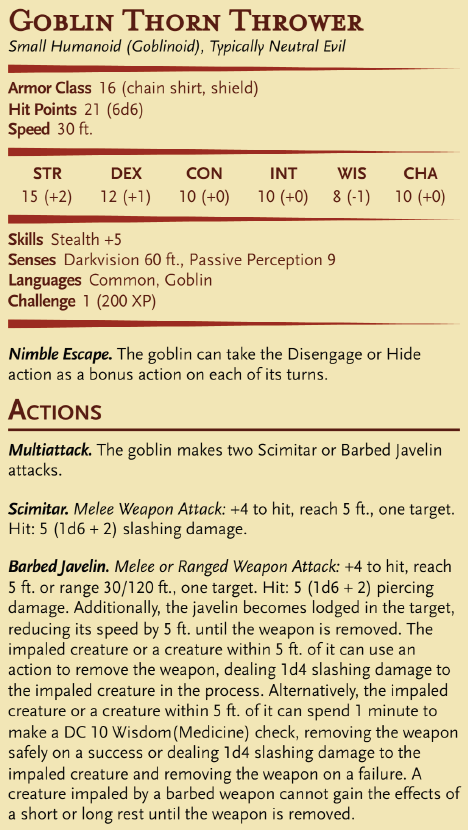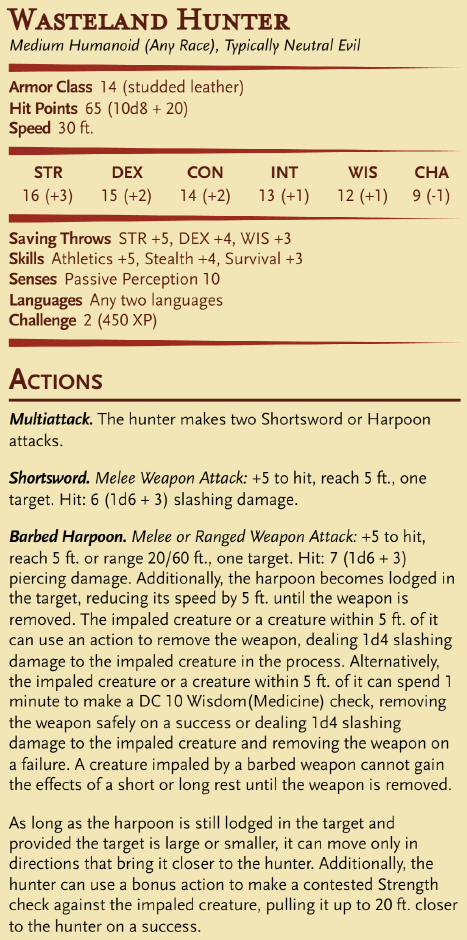I think that D&D 5e has a distinct lack of interesting nonmagical items, especially weapons. The difference between one standard weapon and another is minimal, usually just a slightly larger/smaller damage die or a different damage type. This can contribute towards making the combat in low level or low-magic campaigns feel quite bland.
Barbed weapons are designed to combat these issues by adding a minor debuff and a bit of potential extra damage to targets they hit. They introduce a great way to make mundane weapons a bit more interesting, give martial characters some additional options in combat, and make low level enemies a bit more diverse. Barbed weapons will have you hooked in no time!
Sorry, I just couldn’t resist the pun…
Barbed Weapon
Weapon (javelin, spear, or trident), common
The piercing tip of this nonmagical weapon is covered in hooked barbs. When you hit a creature with a ranged attack using this weapon, it becomes lodged in the target, reducing its speed by 5 ft. until the weapon is removed. The impaled creature or a creature within 5 ft. of it can use an action to remove the weapon, dealing 1d4 slashing damage to the impaled creature in the process. Alternatively, the impaled creature or a creature within 5 ft. of it can spend 1 minute to make a DC 10 Wisdom(Medicine) check, removing the weapon safely on a success or dealing 1d4 slashing damage to the impaled creature and removing the weapon on a failure. A creature impaled by a barbed weapon cannot gain the effects of a short or long rest until the weapon is removed.
Variant: Barbed Ammunition
If you’d like to expand the use of barbed weapons in your game then you could apply the same principle to ammunition such as arrows or crossbow bolts. Barbed ammunition functions the same as barbed weapons with the additional restriction that the target’s speed is not reduced if its size is large or greater.
Variant: Harpoon
Barbed weapons can make an excellent addition to a seafaring campaign or a nautical enemy in the form of a harpoon. A harpoon is essentially a barbed javelin with a length of rope attached to it. It functions the same as a normal barbed javelin with the following modifications: The harpoon’s range is 20/60 ft. As long as the harpoon is still lodged in the target and provided the target is no more than one size larger than you, it can move only in directions that bring it closer to you. Additionally, you can use a bonus action to make a contested Strength check against the impaled creature, pulling it up to 20 ft. closer to you on a success.
Using Barbed Weapons
Sure, you could have your players find some barbed weapons just laying around, but where’s the fun in that? I prefer to introduce them by having enemies use them against the party first. Enemies that are especially cruel, crafty, or just need to slow their prey down would all make great use of barbed weapons. I’ve provided two example stat blocks below that you can use as inspiration or just straight up steal for your own game.
Goblin Thorn Thrower
Goblins are excellent candidates for introducing barbed weapons into your game. They are generally quite crafty and goblin hunters or groups that live in the wilds could use barbed spears or javelins to hunt game that is faster than them. The Goblin Thorn Thrower could be used as part of a goblin hunting party or even as the leader of an entire group of goblins.
Wasteland Hunter
Wastelands are a dangerous place. The people that call these desolate places home need to be resourceful and ruthless to survive. Food and resources are scarce so once you’ve found some, whether it be a dangerous beast or an unsuspecting adventuring party, you can’t let it escape. The Wasteland Hunter uses their barbed harpoon to impale their target before reeling it in for the final kill.
Downloads
A PDF containing the barbed weapon item description as well as the Goblin Thorn Thrower and Wasteland Hunter stat blocks can be downloaded here. This PDF was generated using the Homebrewery tool.


